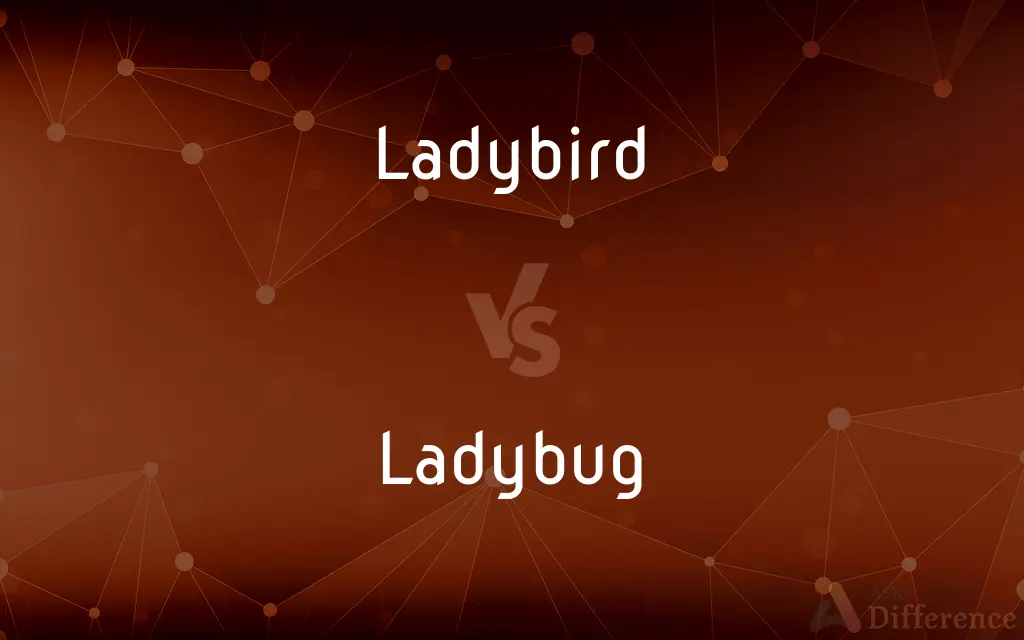Ladybird vs. Ladybug — What's the Difference?
By Tayyaba Rehman — Updated on October 19, 2023
Ladybird and Ladybug both refer to the same small beetle, but "Ladybird" is primarily British English, while "Ladybug" is American English.

Difference Between Ladybird and Ladybug
Table of Contents
ADVERTISEMENT
Key Differences
Ladybird is a term that has been used for centuries to describe a group of beetles known for their round shape and often bright coloration. In contrast, Ladybug is the term predominantly used in the United States to describe these same beetles.
Both Ladybird and Ladybug refer to the beetles from the Coccinellidae family, recognized for their beneficial role in pest control as they consume aphids. Whether you call it a Ladybird or a Ladybug, the creature remains a gardener's friend.
The name Ladybird might sound peculiar for a beetle, but it has religious origins, often linked to "Our Lady", the Virgin Mary, with the red coat representing her cloak. Similarly, while Ladybug takes on the "bug" terminology common in the U.S., its origin is likewise associated with the Virgin Mary.
While both terms are interchangeable in meaning, regional usage dictates preference. If you're in the UK, you're likely to hear Ladybird, whereas in the U.S., Ladybug is the common term.
Irrespective of the nomenclature, whether Ladybird or Ladybug, these beetles have been subjects of children's rhymes, stories, and are often seen as symbols of good luck around the world.
ADVERTISEMENT
Comparison Chart
Geographical Usage
Predominantly used in the UK and other Commonwealth countries.
Mainly used in the United States.
Meaning
A beetle from the Coccinellidae family.
A beetle from the Coccinellidae family.
Etymological Origin
Derived from "Our Lady", referencing the Virgin Mary.
Also has associations with the Virgin Mary.
Popular Cultural Context
Found in British children's rhymes and stories.
Commonly mentioned in American children's literature.
Color Variations
While often red, Ladybirds can be yellow, orange, or other colors.
Same as Ladybird, Ladybugs can vary in color.
Compare with Definitions
Ladybird
A beneficial insect for gardeners due to its diet of aphids.
I never use pesticides; the Ladybirds handle the aphids.
Ladybug
A small, round beetle, often red with black spots.
My niece loves chasing Ladybugs in the backyard.
Ladybird
A member of the Coccinellidae family of beetles.
We learned about the Ladybird's lifecycle in school today.
Ladybug
A predator of pests like aphids, beneficial for gardens.
The rose bushes are thriving thanks to the Ladybugs.
Ladybird
An insect often associated with folklore and superstitions.
Seeing a Ladybird is considered good luck in many cultures.
Ladybug
An insect with four life stages: egg, larva, pupa, and adult.
The children watched the Ladybug transition from pupa to adult.
Ladybird
A small beetle with a dome-shaped back, often red or yellow with black spots.
The garden was teeming with Ladybirds in the summer.
Ladybug
A beetle belonging to the Coccinellidae family.
There's a Ladybug exhibit at the local science museum.
Ladybird
A beetle that undergoes a complete metamorphosis.
From larva to adult, the Ladybird's transformation is fascinating.
Ladybug
A symbol of good fortune in various cultures.
She wore a Ladybug pendant for luck.
Ladybird
See ladybug.
Ladybug
Any of numerous small, rounded, usually colorful beetles of the family Coccinellidae, often reddish with black spots and feeding primarily on other insects, including pests such as scale insects and aphids. Also called lady beetle, ladybird.
Ladybird
Any of the Coccinellidae family of beetles, typically having a round shape and red or yellow spotted elytra.
Ladybug
(North America) ladybird.
Ladybird
Any one of numerous species of small beetles of the genus Coccinella and allied genera (family Coccinellidæ); - called also ladybug, ladyclock, lady cow, lady fly, ladybeetle, and lady beetle. Coccinella seplempunctata in one of the common European species. See Coccinella.
Ladybug
Same as Ladybird.
Ladybird
Small round bright-colored and spotted beetle that usually feeds on aphids and other insect pests
Ladybug
Small round bright-colored and spotted beetle that usually feeds on aphids and other insect pests
Common Curiosities
Do all Ladybugs have spots?
No, while many have spots, some Ladybugs might be spotless or have stripes.
Are Ladybird and Ladybug the same insect?
Yes, they refer to the same insect but have regional naming differences.
Is the term Ladybird used in the U.S.?
While Ladybug is more common in the U.S., some might use or recognize Ladybird.
Why is it called a Ladybird?
The term has religious origins, often linked to "Our Lady", the Virgin Mary.
Are Ladybirds beneficial for gardens?
Yes, Ladybirds consume pests like aphids, making them helpful for gardens.
Do Ladybirds undergo metamorphosis?
Yes, Ladybirds go through four stages: egg, larva, pupa, and adult.
Are there yellow or orange Ladybugs?
Yes, while red is common, Ladybugs can also be yellow, orange, or other colors.
Is the Ladybird a symbol of good luck worldwide?
In many cultures, the Ladybird is indeed seen as a good luck charm.
Do Ladybugs bite?
Rarely. While they can bite, it's not common and usually isn't harmful.
Do both terms refer to beetles from the Coccinellidae family?
Yes, both Ladybird and Ladybug refer to beetles from this family.
Is there a specific reason for the spots on a Ladybug?
The spots might deter predators by signaling that the Ladybug might taste bad or be toxic.
How do you differentiate between male and female Ladybirds?
It's challenging to differentiate by just looking, as both sexes appear similar.
How long do Ladybirds typically live?
Their lifespan can vary, but many live for about a year.
Can you keep a Ladybug as a pet?
While possible, Ladybugs are best left in the wild to fulfill their ecological role.
Are there black Ladybugs with red spots?
Yes, there are some species of Ladybugs that are black with red spots.
Share Your Discovery

Previous Comparison
Complain vs. Complaint
Next Comparison
Bung vs. BungstarterAuthor Spotlight
Written by
Tayyaba RehmanTayyaba Rehman is a distinguished writer, currently serving as a primary contributor to askdifference.com. As a researcher in semantics and etymology, Tayyaba's passion for the complexity of languages and their distinctions has found a perfect home on the platform. Tayyaba delves into the intricacies of language, distinguishing between commonly confused words and phrases, thereby providing clarity for readers worldwide.
















































